IV. Dvakrát Svatý
Václave (St. Wenceslas, Twice)
One of the most potent
and widely recognized musical symbols
of Czech nationalism is the chorale
melody or spiritual folk song Svatý
Václave,
which honors the famous king of the
Přemyslid dynasty that ruled the
Czech lands for much of the middle ages.
Václav, who was murdered and
succeeded by his brother Boleslav the
First, was later beatified as a patron
saint of the Czech lands. Along with
the spiritual song "Hospodine,
pomiluj ny" (Lord Have Mercy Upon
Us), which dates from the tenth century,
the chorale honoring Saint Wenceslas,
as he is known to the English speaking
world, is one of the oldest surviving
monuments of Czech music.
Reverence for Saint Wenceslas
actually inspired at least two tunes
in his honor, whose first verses share
a nearly identical text. The melody
to be considered initially is the one
used by Martinů to such stirring
effect in his Czech
Rhapsody of
1918, whose first performances celebrated
the founding of the newly independent
Czechoslovakia at the end of the First
World War and brought the composer’s
work before a large audience for the
first time. The example below shows
the melody used by Martinů in that
work:
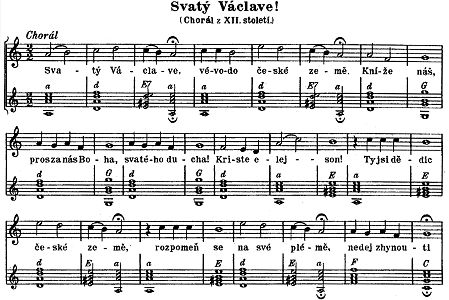

(Text translation: Saint Wenceslas,
Duke of Bohemia, Our prince, Pray to
God for us,
And to the Holy Ghost! Christ have
mercy! ...)
Josef
Suk, Martinů’s composition teacher
at the Prague Conservatory and Dvořák’s
son-in-law, had also used this tune
in his Meditation
on the Old Czech Hymn "St. Wenceslas"
for string quartet (or string orchestra)
written in 1914. It is symbolic that
both works should frame the years of
the War, given the dark character of
Suk’s Meditation
and the more triumphant qualities of
Martinů’s Czech
Rhapsody. In
the following passage from Suk’s work
(orchestral version), various strands
of the melody are treated simultaneously.
First, the cellos intone the pitches
on "Kriste elejson", followed
by "proz za nás Boha"
in the first violin, "Svatý
Václave" in first and second
violins (against pizzicato "proz
za nás Boha" in the remaining
strings). Finally, "vévodo
české zemĕ” is heard in the
first and second violins:
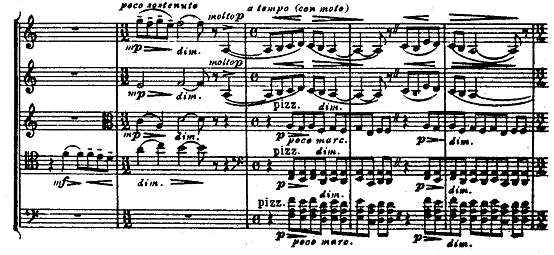
Martinů’s
use of the tune in his Czech
Rhapsody is
much less elaborate than Suk’s treatment
in the Meditation, focusing almost
exclusively on the characteristic five-note
motive, A-G-A-F-G, set to the text “proz
za nás Boha.” This fact proves to have
later significance when examining how
Martinů employed this material
in his Parisian works.
As already mentioned, a second melody
set to the same text is also extant.
According to the captions below, the
tune also dates from the twelfth century,
but the source listed is dated 1473.
For convenience this tune will henceforth
be referred to as SV2 and the one quoted
above as SV1:

It
is striking that Martinů should
resort to the extensive use of both
melodies right at the beginning his
Paris years, setting an example for
himself that he follows with remarkable
frequency. The early context of their
use is particularly fascinating, however.
As observed in the chapter devoted to
Martinů’s new approach
to rhythm, Stravinskian collage quickly
became a characteristic of Martinů’s
stylistic re-orientation in Paris. This
aspect is particularly salient in the
first substantial work to be written
by Martinů in France, his Quartet
for clarinet, horn, cello
and side drum. Examination of the score
proves that the entire composition is
a parody of both versions of Svatý
Václave. A melodic fragment
taken from SV2 opens the work, already
ironically transformed into an "objective"
cell. In the same way a popular
tune can be ragged, Martinů dissects
and rhythmically distorts the chorale
tune so that it is barely recognizable.
Here the main motive used consists of
the four pitches on “Václave” (written
pitches G-F#-D-E), treated in pairs
and frequently reversed in
order of appearance in the solo clarinet
part:

Next, all three pitched instruments
simultaneously play variations on the
motive, creating a collage of randomly
overlapping, fragmented ideas. An espressivo
melody appears in the clarinet, also
obviously based on the same motive.
This rises sequentially to a grand climax
accompanied by the motive in diminution
in the horn and cello:
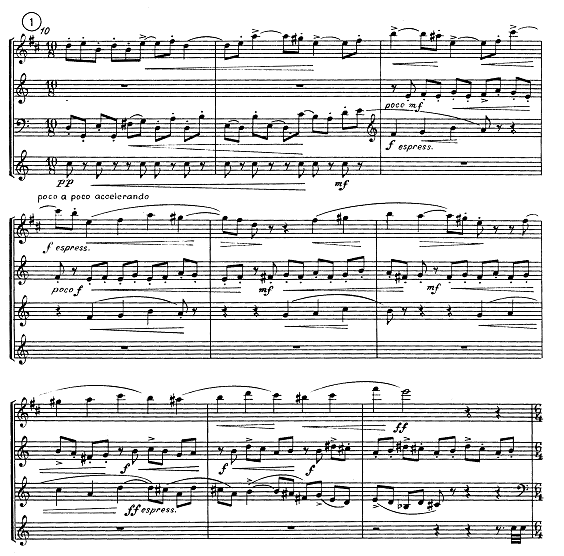

Later in the movement
a breezy tune is introduced imitatively
in the clarinet and horn, which proves
to be concealing
Martinů’s favorite turn of phrase
from SV1 (A-G-A-F-G - corresponding
to the clarinet’s written pitches in
the following example). Other fragments
of SV1 appear; the horn part twice has
a rising and falling motive set to the
pitches on the words “Svatý
Václave”
and the clarinet switches to an embellished
variant (added notes in parentheses)
from SV2 (“České zemĕ, knĕže
náš”):

In the slow movement,
SV1 dominates in another parody, but
of a more soberly expressive variety.
Curiously, the entire movement is framed
by an altogether different tune in apparent
chant style. The melody for cello solo
is meditative, and with its gravity
seems to possess a distinct Slavic flavor.
After so much fragmentation in the first
movement, the long-breathed, sixteen-measure
melody in Dorian mode comes as a complete
shock. The recitativo style includes
speech-like rhythms, further suggested
by the repeated notes. One is reminded
of a similar passage in the slow movement
of Tchaikovsky’s third string quartet,
which represented
the intoning of the priest at a requiem
mass. Here is Martinů’s melody:
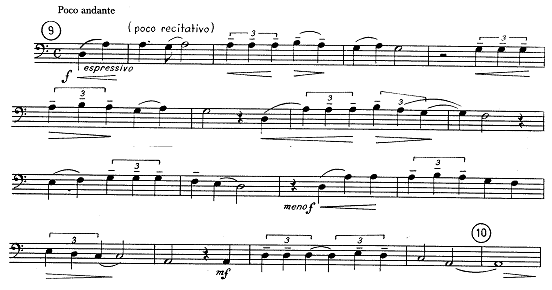
Framed by this tune, which returns
to conclude the movement, somber fragments
of SV1 and SV2 come in and out of focus.
Occasional, distant fanfares from the
side drum seem to suggest some sort
of war memorial. Here are two statements
in the clarinet, several measures apart.
They both begin with the "Svatý
Václave" motive from SV1,
but while the first continues with the
characteristic five-note motive from
SV1, the second continues with the opening
of SV2. Both versions are slightly embellished
in a manner typical of the entire work:


The third movement returns to the highly
syncopated style of the first, and again
the primary material is based on Svatý
Václave. Here is a notable
example, in the horn part, of the five-note
motive from SV1 being playfully treated.
At first it coincides with the 5/8 meter,
but then is shifted across the bar line
by an extra note:

Here
Martinů also builds longer tunes
from this same five-note
phrase, in this case extending the first
three oscillating notes before the final
two are heard in the last measure. This
technique was also observed in the previous
chapters:

What
is the significance of Martinů’s
use of this material in this work? The
composer destroyed many of the works
written during this experimental apprentice
period with Roussel, but spared the
Quartet. This perhaps indicates its
aesthetic value to Martinů, even
if the work never saw the light of day
during his lifetime,
being published posthumously in 1975.
The Quartet’s significance resides in
the contradictory ways in which the
composer uses one of the most familiar
Czech musical symbols. Certainly the
slow movement, with its distinct echoes
of Suk’s Meditation, would fit
comfortably into the category of traditional
use of the material, even if some modern
quirks occasionally raise the eyebrow.
But the outer movements treat the tune
irreverently in a quasi-Stravinskian
collage, fragmenting and objectifying
its beloved
strains. This could not contrast more
with Martinů’s use of SV1 in the
luminously optimistic closing pages
of his 1918 Czech
Rhapsody.
There is a stylistic
inconsistency in the Quartet that is
intriguing, and it is tempting to chalk
it up as confusion on the composer’s
part and his inability to successfully
integrate his musical materials in a
consistent manner. The composer’s fondness
for juxtaposing conflicting materials
in various ways and for various effects
merits careful consideration, however.
In the case of the Quartet, the music’s
stance toward nationalism can be interpreted
in different ways. One would be apparently
skeptical, or at least dubious in a
metaphorical sense, as the national
element is absorbed into contemporary
technique and dissected into motivic
fragments, losing all symbolic significance
in the process. In this case, even the
slow movement might be regarded as a
memorial service for the national element,
which must now yield to the exigencies
of the cosmopolitan approach.
Certainly Martinů must have been
mulling over these issues when he arrived
in Paris and was confronted with an
entirely new musical world.
In
another view, Martinů could be
seen as having the best of both worlds
in the Quartet. Here he can cleverly
bury national elements
in his work, giving himself a sense
of grounding by using familiar material
while dealing with the imperative to
compose in new ways. At the same time,
he can produce a more frankly nationalistic
slow movement invoking the meditative
world of Suk, creating a shocking juxtaposition
to the witty, irreverent outer movements.
All of this is done with a playful sense
of irony and the feeling that the last
note has not been written on the subject.
By
turning now to Martinů’s continued
use of Svatý
Václave
in his Parisian works and beyond, a
better understanding of the composer’s
intentions can be reached. Before
examining more of Martinů’s oeuvre
in this regard, however, it is prudent
to point out that
a short five-note motive such as that
from SV1 is inclined to appear quite
by accident or coincidence. In the following
two examples by Stravinsky and Debussy,
it is safe to say that neither composer
had Saint Wenceslas in mind when they
wrote them. The Stravinsky example comes
from the Rite of Spring, and
is one of the "folk tunes"
featured in the ballet. This demonstrates,
of course, that the SV1 fragment has
a kinship with folk melodicism:

In Debussy’s Nuages,
the first of his three Nocturnes,
the opening ostinato in the clarinets
sounds the notes from SV1 in the first
five pitches. Martinů was probably
aware of the coincidence, for he knew
the Nocturnes
well, mentioning them specifically in
a radio interview shortly after his
arrival in America in 1941.

If it is advisable to proceed with
caution, then, with regard to accidental
sightings, there is nonetheless a very
persuasive body of musical evidence
demonstrating that both Svatý
Václave melodies continued
to provide the composer with raw melodic
material in an intriguing variety of
contexts. To begin, there is no need
to look further than chronologically
neighboring works to the Quartet
such as Half-time and La Bagarre.
In Half-time, the four-note
motive on "Václave"
from SV2 is grafted onto an important,
oscillating four-note motive heard earlier
in the piece. Here is an example of
the four-note motive (last three bars)
without SV2:


The wedding of this motive with SV2
is saved for the climactic moment of
the piece, evidently representing the
crowd at its most fevered pitch:

Like the four-note "signature"
motive from SV2, the five-note motive
from SV1 is no doubt favored
by Martinů because of its clearly
recognizable melodic shape. It is not
surprising then, that La
Bagarre makes
use of the five-note SV1 motive in his
grand "folk" tune representing
the masses. Here, the national element
is indeed elevated to the universal
(note: the melody occurs in the treble
clef, which has been accidentally omitted
from the score):

In
several other instances spaced well
apart during his stay in Paris, Martinů
employs this motive in similar, elevated
tones. In the third piece
of his Quatre Mouvements for
piano (1929), the motive appears as
part of a heroic-sounding folksong.
The notated rubato
here is very interesting, recalling
Moravian folk song and the folk style
of Janáček. Not coincidentally,
the only note which is not
part of the motive is marked staccato,
while the other notes which do belong
are marked tenuto or are accented:
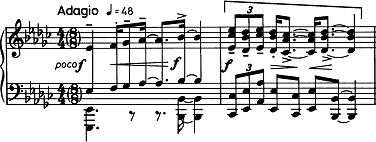
The initial rising and falling motive
of SV1 is also featured here, again
with a notated rubato akin to improvised
song:
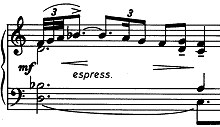
At other times Martinů
also singles out this rising and falling
figure for special treatment, as the
following examples from the slow movement
of the String Quartet No. 3 demonstrate.
Here the progression, treated in nearly
parallel fashion, is a very modern adaptation
of the fauxbourdon
style of the Renaissance:
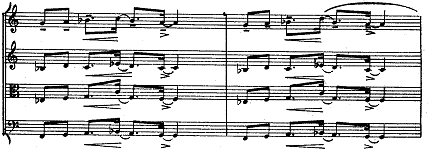
Later
in the movement, Martinů evokes
the world of Bartók’s string quartets
with a haunting passage featuring semitone
tremolandi
scored a minor ninth apart, accompanying
the tune in the cello’s extreme upper
range. As in the last example, the figure
dispenses with the last note of the
original motive, presumably to avoid
a circumscribed, dead-end effect:
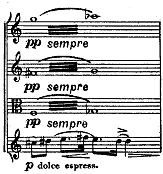
Returning to the discussion
of the more frequently used five-note
motive from SV1, another notable example,
taken from the slow movement of Sonatina
for two violins and piano
(1930) is shown in the excerpt below.
Martinů treats the motive sequentially,
and again it is heard at the climax
of the movement:

More
dramatic, however, is Martinů employment
of the motive in his Double Concerto
for two string orchestras, piano and
timpani (1938). This work is widely
regarded as one of Martinů’s masterpieces
and has a seriousness and depth of expression
emblematic of the dark times during
which it was composed.
The opening of the Largo features
fragments of the motive in the piano
part (not the main melody, which is
given to the violins). Initially only
the first three notes are heard, and
then four, but the entire motive never
reveals itself. This could be a metaphor
for the uncertainty of Czechoslovakia’s
fate during the Munich Crisis, and in
any case reflects the atmosphere of
fear and tension which permeates the
work:

In other works, as in
the 1924 Quartet examined earlier, Martinů
does not hesitate to subject SV1 to
a more rhythmic treatment, building
short cellules from its motive, as the
following examples demonstrate. In the
first movement of the String Quartet
No. 2, it becomes the primary material
of the Allegro
vivace,
providing the first five notes of the
seven-note cell. The material is used
in a modern, rhythmic style, which sets
it apart from the very “French” sounding
introduction, the end of which can also
be seen in the excerpt. This seems to
depict Martinů leaving
the world of impressionism behind in
favor of dynamism, with a transformed
Svatý Václave symbolic
of the process:
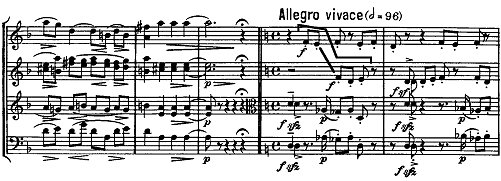
(Providing
an interesting comparison, Martinů
returns to this concentrated approach
more than a decade later in the first
movement of his
String Quartet No. 5 (1938), where the
SV1 motive is shared by two consecutive
rhythmic ideas:
 )
)
Returning to the Second Quartet, the
initial motive seen above is soon transformed
into a lively folk dance, now in the
major mode. Each voice in the quartet
contributes different ostinati, including
the one in the second violin based on
the familiar secondary ragtime pattern:
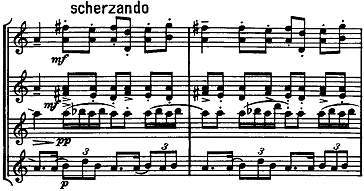
The first movement of the String Quartet
No. 3 (1929) continues along this path,
but with more sophisticated overlapping
ostinati of different lengths (bracketed
in the example), creating an interesting
polyrhythmic texture. Here, Svatý
Václave emerges from an oscillating
motive in the first violin:
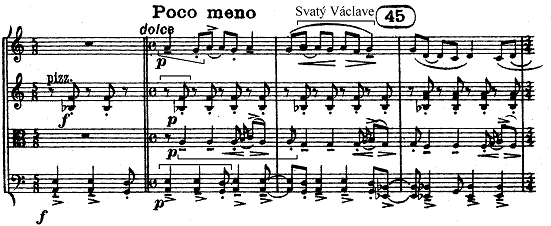
Similar syncopated treatment of the
SV1 motive occurs in the finale of the
Cello Concerto no. 1 (1930) where it
appears in hemiola patterns across measures
two to three and five to six of the
following excerpt:

Decidedly
more cheerful than the preceding two
examples is the following excerpt from
Martinů’s “Koleda
Milostná" (Love Carol, 1937)
where two motives from SV1 separately
provide the melody and accompaniment
in a clever combination that totally
transforms the original material:

In the finale of the Tre ricercari
(1938) another scherzando treatment
of the motive occurs, but with an entirely
different character. This is heard in
the solo oboe, which treats the fragment
in a rather bluesy fashion, while the
ensuing modulating scale further reflects
the initial tension between F and F#:

Later in the movement the conflict
between the major and minor third becomes
vertical rather than horizontal, with
the motive from SV1 made more apparent
through accentuation:
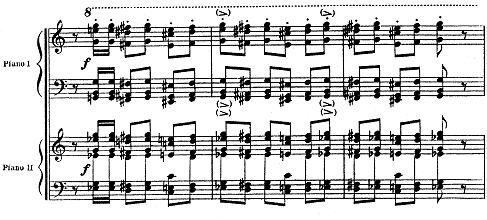
A similar chordal, percussive use of
the motive appeared over a decade earlier
in the first movement of the Impromptu
for violin and piano (1927). Here jazz
holds sway, with typical 6/4 chords
moving chromatically in the left hand
of the piano against the SV1 fragment
and a wildly disjunct violin part:
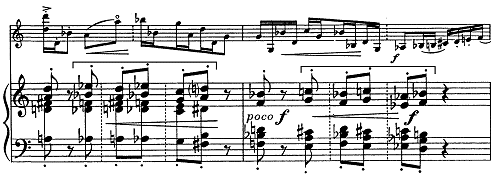
Martinů’s
use of SV2 also shows great variety,
but often the composer uses its signature
four-note motive in passages of melodic
and harmonic tension. Perhaps he recognized
the chromatic harmonic possibilities
inherent in the first two notes of the
motive. At any rate,
in a characteristic example from the
first movement of the String Sextet
(1932), the expressive possibilities
of this more chromatic approach can
be seen. The motive is repeated with
increasing tension against underlying
progressions that are quite dissonant
(for example, the first viola and cello
are a minor ninth apart):
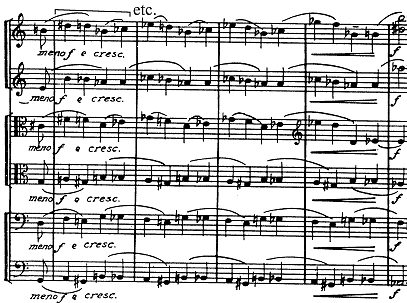
In the climax of the Sextet’s
slow movement this music
returns with even greater intensity,
with all instruments in an extremely
high register. Again, Martinů is
affording special emotional significance
to the motive for his own expressive
purposes:
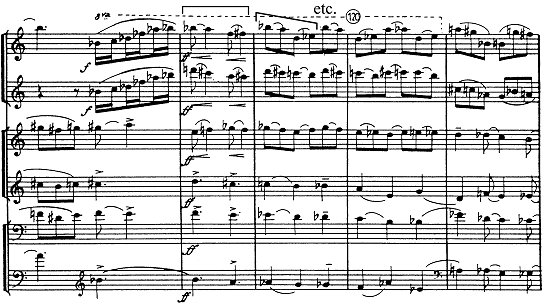
A few further examples
serve to demonstrate the diversity
of Martinů’s treatment of this
motive as well. In the first of Cinq
pièces breves
for violin and piano (1929), SV2 is
pitted humorously against the Charleston.
This proves to be another example of
Svatý Václave intruding
into an explicitly jazz-inspired context,
which is instructive:

Another curious instance is the appearance
of the motive in Le Depart, a
symphonic interlude to the jazz opera
Les Trois souhaits. This intense,
densely orchestrated tone poem has little
lyrical content, but does feature an
appearance of SV2 as a legato oboe solo
in the middle of the work. Here the
motive is curiously slurred in contrary
fashion, creating a different melodic
shape. Of course this is not exactly
lyrical either with its endless repetition,
but it does stand out from the rest
of the generally thick orchestral texture.
Perhaps in its sobriety it reflects
the subtitle to the opera, "The
Vicissitudes of Life", like the
pastoral example quoted from this work
in the preceding chapter:

Martinů
is also fond of
combining the two versions of Svatý
Václave, as was already observed
in the 1924 Quartet. In line with the
aesthetic of that work is the humorous
trifle Instructive Duo for the Nervous
(1925), with rhythmic complexities seemingly
designed to slip up the poor pianist.
The example below gives some hint of
this feature, but in the music that
continues beyond it the rhythmic combinations
actually become much more challenging.
In the left hand at the beginning, various
patterns limited to four pitches spell
out both characteristic motives, and
in the case of SV2 (marked with x’s)
the initial three pitches are also thrown
in for good measure:

In the scherzo of the Sonata for flute,
violin and piano, more playful references
to both motives occur. The piano part
is missing the first note of SV1, but
this is soon supplied surreptitiously
by the lower E of the violin’s pizzicato
double stop. In the flute SV2 is distinctly
heard in the middle of the bucolic figure:
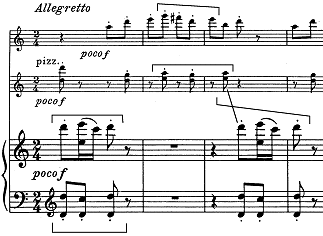
Another imaginatively conceived example
occurs at the end of the trio section
of the Selanka (Idyll) movement
of the cantata Kytice (Bouquet
of Flowers). Here, two statements in
pastoral mode combine the two characteristic
motives. The oboe and flute play their
solos unaccompanied in a bridge leading
to the da capo. In the oboe solo,
SV2 clearly occurs twice (upper brackets),
but the first occurrence also conceals
the beginnings of SV1. The flute solo
begins similarly and features the same
number and kind of motives, but is extended,
with the motives no longer overlapping,
and in this case SV1 is saved for last:


In the fifth movement of the piano
cycle Les Ritournelles, the
chant-like melody that opens the work
weaves two statements of SV1 while at
the same time hinting at SV2, once again
underscoring the relationship between
the two motives:

At the conclusion there is a distant-sounding
reminiscence of the opening melody,
but here the melodic shape reflects
SV2 instead of SV1. In a final gesture
towards Svatý Václave,
the consecutive fifths from the passage
above return as chords in the bass,
outlining the rising and falling figure
that opens SV1. With its emphasis on
chant-like tunes and a nod towards fauxbourdon
texture, the passage reflects the sound
world of more ancient times:

Perhaps most interesting
of all of these combinatorial gestures
cited is the following example from
the end of the first movement of the
String Quartet No. 5. It has previously
been demonstrated that the main material
of the movement is based on SV1 (see
example above). At the end SV1 returns,
but is stretched out and in retrograde
(with a the third and fourth notes repeating
before arriving at the final note).
Following backwards, SV2 can be detected
as well (with the initial interval altered
to a major
second). The melody, given to the upper
register of the viola, is an anguished
cry set against sharp chords in the
remaining strings, and one of the most
powerful passages in Martinů’s
oeuvre. It is curious that he apparently
created it from this kind
of
technique. Perhaps this is one example
of accidental occurrence, for Martinů
is once again working within the restricted
range of four notes, which are of course
limited in their possible combinations:

The remainder of this
discussion will focus once
again on SV1, to which Martinů
apparently attaches special significance.
This can be gathered from the relative
number of times it is encountered in
his works, and especially from the typically
lyrical and pastoral veins in which
it often appears. The
slow
movements of the first two numbered
violin sonatas (1929 and 1931), for
example, show Martinů crafting
tender melodies from the kernel of the
five-note motive. The first sonata’s
melody is embellished by gently syncopated
chords in the piano, and initially
does not venture beyond the motive.
By contrast, the second sonata builds
an ingratiating melody with the motive
as its departure point. Both are characteristic
examples of Martinů’s music at
its most lyrical:


Another lyrical instance
occurs in the third movement of Les
Ritournelles.
Here Martinů’s familiar oscillating
melodic style is used to build a long
melodic line, into which SV1 is seamlessly
inserted (note how it is slurred separately,
however). In the right hand, falling,
oscillating thirds
are treated successively, with the gently
floating feeling emphasized by the first
inversion F major triad that opens the
piece. The left hand is also treated
in oscillating patterns, but chromatically,
mirroring the slow descent of the thirds
in the right hand. As if to underscore
the link to impressionism, rhythmic
regularity is nowhere to be found, and
the excerpt lacks bar lines:

With such an emphasis
on delicate lyricism the pastoral cannot
be far behind, and there are in fact
many instances
of Martinů using Svatý
Václave
in pastoral style in addition to the
examples from Kytice cited above.
It is not surprising to find one in
the Rhapsody of 1928 (also named
La Symphonie), since it recalls
the tenth anniversary of Czechoslovakia’s
independence,
and hence looks back to Martinů’s
Czech Rhapsody
composed in 1918. In the Rhapsody,
the middle section is a pastoral featuring
the English horn. Here Martinů
symbolically recreates the hushed atmosphere
of the Largo
of Dvořák’s Symphony, “From the
New World," with the English horn
offering a pentatonic embellishment
of SV1. This musical landscape features
a plagal cadence suggesting the gratitude
of the nation. The simplicity is striking
given the agitated, dynamically conceived
music that characterizes the remainder
of the work. The music seems to evoke
the moment, frozen in time, in which
the national flag was handed over to
the first Czechoslovakian regiment at
Darney in the first "grand, solemn
act in the independence of Czechoslovakia:"
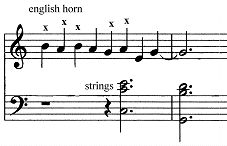
The
pastoral again plays a memorable role
in the slow movement of Martinů’s
Cello Concerto No. 1 (1930). The melody
flirts with the motive as it oscillates
back and forth before finally yielding
the fifth note. The metrical arrangement
and resulting pattern
of note lengths creates a floating effect
emphasizing that time has no meaning
in this static pastoral tableau. The
harmonies are chiefly nonfunctional
triadic progressions, reminiscent of
the third relationships commonly found
in pastorals, with plagal cadences added
to increase the serenity of the setting.
The overall progression is I-V (ending
on V of V):

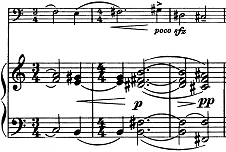
In the subsequent musical paragraph,
the orchestra takes up a more straightforward
statement of the motive, as Svatý
Václave continues to play
an important in the movement:
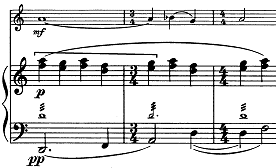
Based upon the evidence
of this circumscribed study of Svatý
Václave
it is apparent that Martinů used
this material far more often than has
been previously acknowledged, and that
such borrowing constitutes an essential
part of his aesthetic.
In this tendency he followed Stravinsky’s
lead, but in doing so developed a very
personal and long-term approach to the
use of pre-existing material. Indeed,
as a war refugee in America, and in
the composer’s words "a man without
a country,"
Martinů returns to Svatý
Václave
with renewed conviction. The Violin
Concerto No. 2 could be cited as a remarkable
example, with its anguished, almost
apocalyptic outburst of SV1 (the five-note
figure) in the opening measures of the
work, betraying its wartime origins:
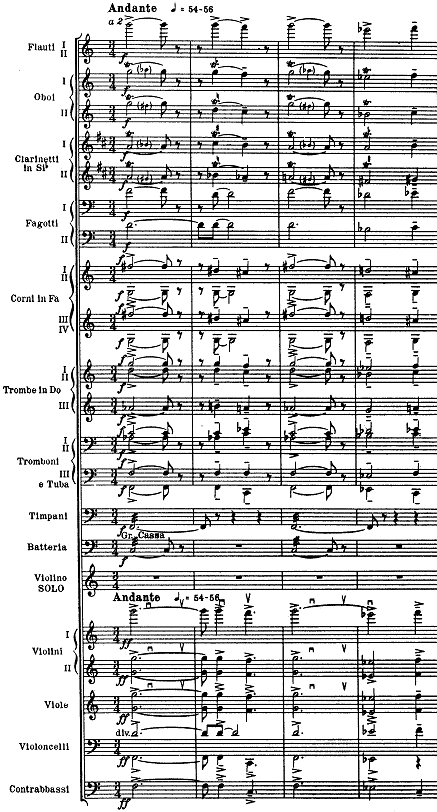
A variety of techniques
favored by the composer have been observed
as he transforms the Svatý
Václave
melodic material and builds from it,
with these different approaches forming
a more complete aesthetic image of the
composer. Martinů of
course used Svatý Václave
because of its potency as a national
symbol, but he did not hesitate to subject
it to the rigors of the newer style
he forged in Paris. In one moment this
beloved symbol of the Czech nation could
be transported to the dance hall, and
in the next objectified into a collage
of melodic/rhythmic cells. It could
equally represent the indomitable spirit
of all humanity or the quiet contemplation
of a soul alone in nature’s realm. Ultimately,
the varied strains of Svatý
Václave proved
to be just what Martinů intended
- a springboard from which his creative
imagination could soar.
Introduction
I.
A New Beginning: Life In Paris
II.
How Martinů "Got Rhythm"
III.
Of Folk Tunes, Pastorals, and the Masses
IV.
Dvakrát Svatý Václave
(St. Wenceslas, Twice)
V.
An Aspect of Minor/Major Significance
VI.
Fin de séjour: Julietta
and Musical Symbolism
VII.Conclusion:
Martinů’s Parisian Legacy

